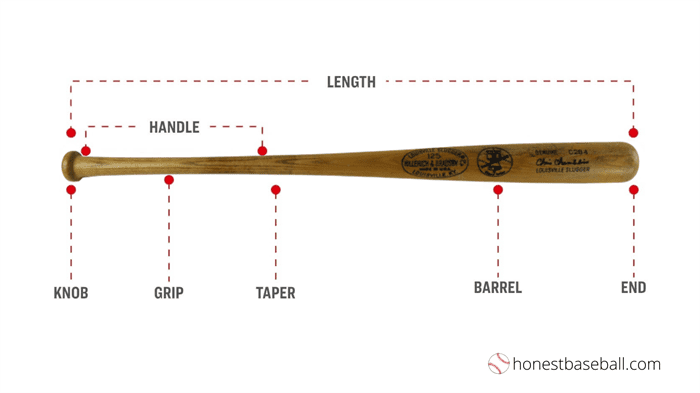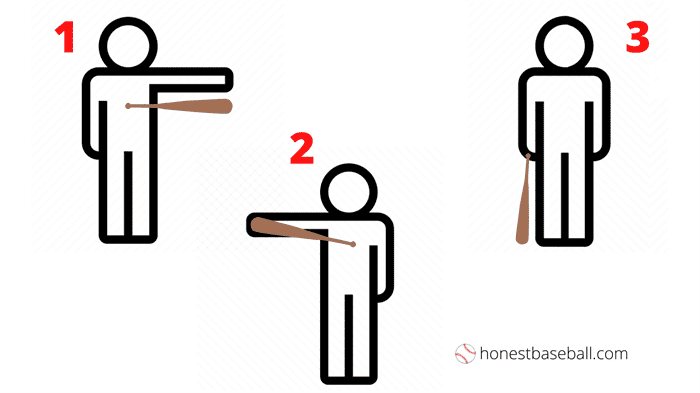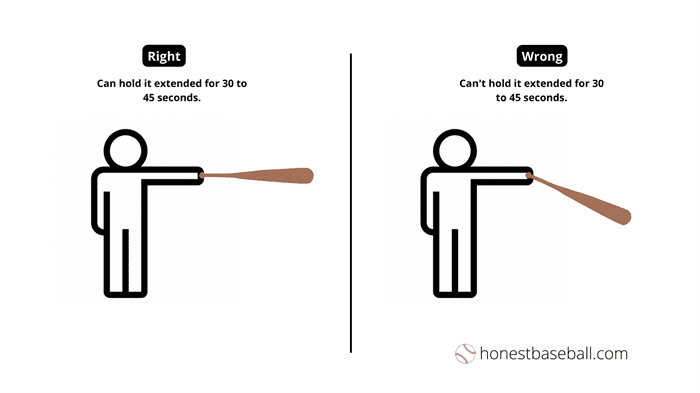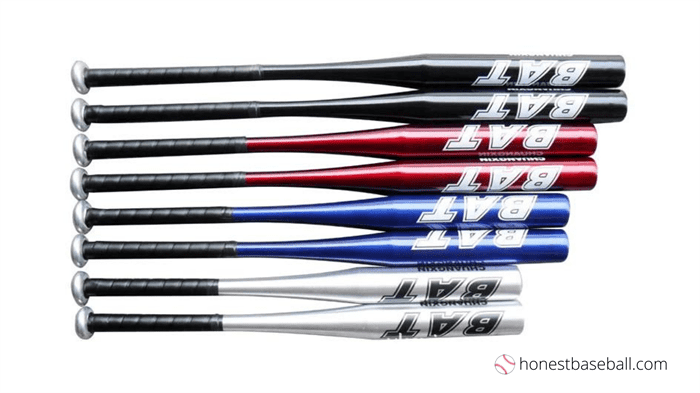Last Updated on October 15, 2023
Are you curious about the weight of a baseball bat? It’s not really that heavy at all.
The average weight for one is around 33 ounces. That’s just under two pounds. However, this can change based on a couple of things. First is what the bat is made of, and second is the size of it.
They can be as light as a bag of sugar! A good balance between hitting power and speed needs to be found when players choose a bat. Different bats have different average weights.

Average Weight of Different Types of Bats
To start, there are three types: wood, aluminum and composite bats. Each type has different weights. Let’s examine one by one.
Composite Bats
Composite bats are created with carbon fiber and plastic. This mixture makes them strong, lightweight, and easy to swing.
The usual weight of a composite bat falls between 18 to 30 ounces. So, it’s not too heavy but still enough weight to hit a ball hard.
Alloy/Metal Bats
These bats are also called aluminum, and they’re popular due to their performance and durability. As you may have guessed, they weigh more than composites.
When people pick up an aluminum bat, they’ll find that it usually weighs between 27 to 30 ounces.
There isn’t much difference, but even so, metal bats don’t need any time to break in. Straight from the shelf, they’re ready for use in a game.
Wood Bats
And finally, we reach the most familiar type of baseball bat, wooden ones.
Wood bats are usually made out of ash, maple, or birch. Since it’s made from natural materials, each model will vary in weight.
Wooden bats can fall within 28 to 32 ounces, but it really depends on how they were built or designed, as well as their shape and size.

Baseball Bat Weight based on Age group.
Bat weight selection based on age group is a crucial consideration when choosing the appropriate bat. It goes beyond the mere composition of materials. The age of the player plays a significant role in determining the ideal bat weight.
Different age groups require bats with varying weight ranges due to the growth and increased strength of players over time. Let’s delve deeper into the weight range for Little League Bats as an example.
Little League Bats
Little League Bats are specifically designed for young players aged between 7 and 13 years old who are still in the process of growing and mastering the game.
Consequently, their bats need to be lightweight, typically weighing between 16 to 20 ounces.
This ensures that these budding athletes can effortlessly swing their bats while still possessing enough heft to make solid contact with the ball.
Youth Bats
As players progress from Little League to Youth League, typically between the ages of 13 and 15, their physical strength and skill level improve significantly.
Accordingly, their bats must align with their enhanced abilities. Youth bats generally fall within the weight range of 18 to 26 ounces.
These slightly heavier bats strike a balance between manageability for growing players and providing sufficient power for effective ball striking.
BBCOR Bats
Moving up the ladder, high school and college players commonly utilize BBCOR (Batted Ball Coefficient of Restitution) bats.
These bats aim to achieve parity among players and function closely to wooden bats in terms of performance characteristics.
Typically used by proficient athletes with adequate strength, BBCOR bats weigh approximately between 26 to 30 ounces.
While selecting a specific weight depends on factors such as player comfort, strength, and hitting style, these bats prioritize balance and controlled swings, emphasizing player skill rather than equipment advantages.
Adult Bats
Upon transitioning into adulthood, players gain further physical strength and expertise in the game, enabling them to wield heavier bats known as Adult or Pro bats.
These bats typically weigh between 28 and 34 ounces and cater to individual preferences, personal strength, and playing style.
Adult bats are meticulously crafted to maximize power and distance, capitalizing on the increased strength and refined skill set of adult players.
Primarily used in professional games, these bats are the heaviest among all age groups.
Average MLB Bat Weight
When observing elite baseball games like Major League Baseball (MLB), where players are fully grown and exceptionally strong, bat weight takes a slight deviation.
These professionals utilize heavier bats compared to younger players.
On average, MLB players bat, weighing approximately 30 to 34 ounces.
This weight range enables them to generate faster bat speed and achieve maximum distance when hitting the ball.
So now, when witnessing a televised home run, one can understand that it is partly due to a perfectly weighted bat in the hands of an experienced player who knows how to leverage its potential.
Recommended Bat Length And Weight For Different Age Groups
| Age Group | Bat Length (inches) | Bat Weight (ounces) |
| 5-7 Years | 24-26 | 13-15 |
| 8-9 Years | 26-28 | 15-17 |
| 10-11 Years | 28-30 | 17-19 |
| 12-13 Years | 30-32 | 19-21 |
| 14-15 Years | 31-32 | 21-23 |
| 16+ Years | 32-34 | 23-30 |
What makes a Baseball Bat Heavier or Lighter?
When you pick up a baseball bat, have you ever wondered what makes it feel like a feather or as heavy as an elephant?
Well, there are several things that can change how heavy a bat is. Here are some of the main factors:
Material: The stuff used to make the bat can change its weight. Bats made from metals may feel heavier than ones made from wood.
Now, if we get into the type of wood bats are made from, called maple, they tend to be heavier than those made with ash.
Size: Think about your toys. Bigger toys usually feel heavier, right? That same principle applies to bats.
Bigger bats often weigh more because there’s just more wood or metal in them. But remember, this isn’t always true. Some bigger bats are designed to be light so you can swing them easily.
Design: The way a bat is designed can mess with how heavy it feels, too.
Sometimes, the handle is made really light while the end of the bat is made heavier. This little trick makes it easier to swing the bat fast.
Light vs. Heavy Bats
There’s a clear difference between light bats and heavy bats. They both have their pros and cons. Light bats are easy to swing, so that you can swing them fast.
This gives you more control, and you can aim your hits better. But there is a downfall: they don’t have much power. So, the ball might not go as far.
Heavy bats, on the other hand, are powerful. When you hit the ball, it goes flying, but they’re hard to swing and can slow you down. Fast swings? Forget about it.
So, if you’re strong enough and can swing a heavy bat fast, go for it!
But if you prefer control and speed, a light bat might be best for you. There isn’t really a perfect answer, though. It all depends on how you play the game.
You’ll never know what works for you unless you try different bats out, so give them all a shot!
| Characteristic | Light Bats | Heavy Bats |
| Weight | Lighter, typically below 30 ounces | Heavier, often above 30 ounces |
| Bat Speed | Faster bat speed, easier to control | Slower bat speed, more power but less control |
| Swing Control | Easier to control, especially for younger players | More challenging to control, requires strength and experience |
| Contact Hitting | Suitable for contact hitters, quick through the zone | Ideal for slower pitches and power to drive the ball |
| Pitch Speed | Effective for faster pitches, quick reaction time | Ideal for slower pitches, and power to drive the ball |
Misunderstandings about the Weight of a Baseball Bat
A common thought is that the weight of a baseball bat is directly related to hitting power.
A heavier bat does provide more mass behind it, but you can’t forget that the hitter’s ability to swing the bat fast is what makes hits powerful. A bat that’s too heavy will slow down your swing and make you lose power.
Another misunderstanding is thinking all professional players use heavier bats. Actually, pros prefer bats with a weight that suits them best.
The right one depends on their style, strength, and how fast they can swing it. It’s not uncommon to see lighter bats being used for quick reflexes and more control over hits.
Different materials can have a significant impact on weight.
Metal bats tend to be heavier than wooden ones. Within wooden bats, some woods are heavier than others as well.
Besides, people think that size alone determines weight. When it makes sense for larger bats to weigh more, they aren’t the only factor.
There’s also design and material, which play a big role in determining how heavy or light specific bats will be.
How to Choose the Right Weight for Your Baseball Bat
If I start expressing my entire journey, then this will take a long time. You have to consider the following variables when deciding the ideal length of a baseball bat for you:
Your Length
- Firstly, you have to place the bat at your side, upright. You have to observe whether the knob of the bat nears the center of your palms. It is dose then it is the perfect baseball bat for you.
- Can you place the bat’s knob against your chest? Are you getting surprised? Yes, by placing a baseball bat’s knob against your chest you can find your perfect baseball bat.
- If you can grab the barrel of the baseball bat by the arms, then you can be sure that it is the perfect bat for you.

- Next, can you straighten your arms by keeping the bat knob nearby to your chest? It is also a strange method, but trust me. Every baseball bat-buying experience has these types of strange and innovative stories. And you can trust me that by this you can find the best one for yourself. When the barrel touches your forefinger, you’ve reached the correct length.
- Lastly, You can also select your baseball bat using your leg. Yes, you can place the bat on any side of your legs. You will get the correct length whenever the bat’s end reaches the middle of your hand.
Your Height
The optimal weight is largely determined by your feeling after holding the bat.
If you feel the bat is too heavy after holding it or you start dropping your bat after a few swings, it’s probably too big or inappropriate for your needs.

Do you want to test? At first, you need to extend your arms to any side while holding the bat’s handle.
Are you sensing it is too heavy for you? It won’t be the one for you if you can’t hold the bat stretched for only 30 to 45 seconds.
Through this, you can understand that the weight factor of the baseball bat is the most important factor in choosing the right baseball bat.

Moreover, the weight and size of the bats can be changed as a result of minor adjustments in the handles.
You can look at the link below to see how baseball bats are made properly if you want to.
Frequently Asked Questions
Does a heavier bat make the ball go farther?
A good guess would be yes since more mass means more potential to drive the ball further. But you also need to consider the player’s swing speed. If the bat is too heavy, it can slow down their swing, which might result in less powerful hits.
Which material is lighter for a bat, metal or wood?
It’s hard to say since this can depend on the type of metal or wood and how the bat was designed. But if I had to pick one, it would be wooden bats.
Are all larger bats heavier?
Most of the time, yes, they are. But not always. Along with size, weight also depends on design and material. So, a small bat can be heavier than a larger one if denser materials are used.
What does drop weight mean, and how does that affect it?
Drop weight is defined as the difference between the length and weight of the bat. For example, a -3 drop means 3 ounces lighter than its length. A higher negative number indicates an even lighter bat.
Can I adjust a baseball bat’s weight by adding or removing something?
It is possible to modify a baseball bat’s performance by adjusting its weight, but this might not be allowed depending on what league you’re playing in. The best approach is to use it as intended by the manufacturer.
Final Thoughts
Now that you have all the information about baseball bat weight, I trust you can make the right choice for your needs.
Selecting the right baseball bat isn’t always easy, especially if you’re new to the game.
With the knowledge you’ve gained from the above, you should be well-equipped to make a wise choice.
how much does a baseball weight
How To Make A Bat Rolling Machine
How Many Stitches are on a Baseball

Hello everyone. My name is Jason Butler, and I live in California, America. I was a professional AAA Minor League Baseball player. I lost my chance of playing MLB for injury issues, but I did not lose my love for baseball. I attended the coaching training program and am now working as a coach in a small school in San Diego.
I always love to share my experience and knowledge if that can help you. Play baseball, and stay fit.
